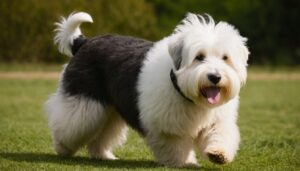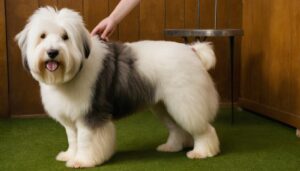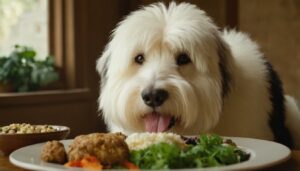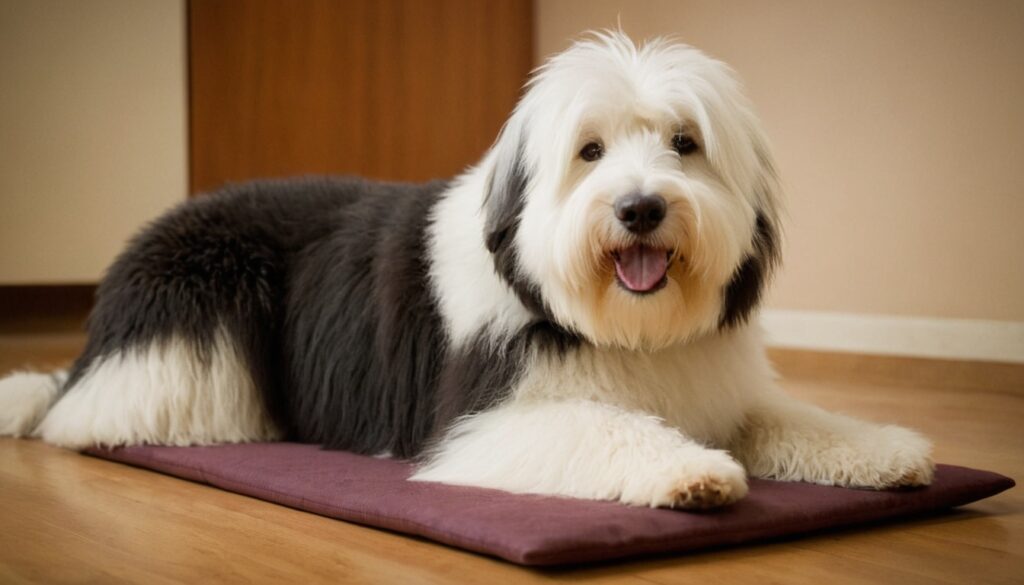Learn all there is to know about the Old English Sheepdog, from temperament and training to grooming, health, and care. Find out whether this large, shaggy breed is for you.
The Old English Sheepdog (OES) is a big, intelligent, and affectionate dog with a shaggy coat and playful nature. Originally bred to herd sheep and cattle, the breed has become a popular family pet due to its friendly nature and strong bond with its owners.
This article will contain:
- History and origin of the Old English Sheepdog
- Temperament and personality
- Training, exercise, and socialization needs
- Grooming and coat maintenance
- Common health issues and lifespan
- Diet and nutritional requirements
- Whether or not you should have this breed
Before you’ve read this article to the end, you’ll have all the information you need on the Old English Sheepdog and how to keep it.
Origin and History of the Old English Sheepdog
The Old English Sheepdog was bred in England during the 18th century. Farmers bred this dog as a working dog to assist in driving animals to market. In contrast to other herding breeds, the OES was bred more as a drover dog and utilized to drive cattle and sheep long distances instead of holding them in position.
Their dense, shaggy coat served to guard them against harsh weather, and their intelligence and trainability made them top working dogs. Their friendly and gentle disposition over time resulted in their transitioning into companion dogs, and they were a common family pet during the 19th and 20th centuries.
Nowadays, the Old English Sheepdog is known as a gentle, smart, and playful dog, ideal for families, working people, and animal lovers.
Old English Sheepdog Breed Characteristics

Size and Form
The Old English Sheepdog is a muscular, strong dog with a shaggy coat. They may look fluffy, but they are athletic, powerful dogs with a heavy build.
- Height: 20 to 24 inches at the shoulder
- Weight: 60 to 100 pounds
- Body: Strong and compact
- Coat: Double, thick, and water-repellent
- Color: Gray, blue, and white are common colors
Temperament and Nature
Old English Sheepdog is a friendly and affectionate dog. It is an intelligent and extroverted dog that will do well in households where it gets plenty of attention and interaction.
- Loyal and Loving: They are friendly with owners and love being included in family activities.
- Playful and Active: They are active and love to play with children and other animals.
- Watchdogs and Guarding: They are guarding and will be excellent watchdogs.
- Intelligent but Obstinate: Intelligent but stubborn students that may become wise minds on their own if they are not worked daily.
Old English Sheepdogs need to be with people and do not prefer being left at home with owners for long times. They would be destructive or worrisome if not suitably brain stimulated and trained.
Training Needs and Exercise Needs

Trained Old English Sheepdog
Old English Sheepdogs are very intelligent and eager to please, but with their strong temperament, they can be difficult to train unless strong patient training is imposed.
- Early Socialization: Introduce them to many different people, animals, and environments at an early age.
- Positive Reinforcement: Reward system with treats and positive reinforcement will be most effective.
- Basic Commands: Teach basic commands like sit, stay, come, and heel.
- House Training: Consistency and a regular schedule will aid in potty training.
- Behavioral Training: Teach good herding behavior early on, as some OES dogs will attempt to “herd” young children or other animals.
Exercise Needs
Old English Sheepdogs are energetic dogs with a strong need to exercise often in order for them to be healthy and well-behaved.
- Daily Walks: At least 60 minutes of exercise daily is suggested.
- Playtime: Activities like fetch, tug-of-war, and agility play are perfect for stimulation.
- Hiking and Outdoor Activities: They love to explore new surroundings and participate in outdoor activities.
- Herding or Obedience Training: Doing things in an organized way helps to fulfill their working-dog nature.
Living a sedentary life makes them obese, destructive, and bored, so it is important to keep them active through exercise.
Grooming and Coat Care

The Old English Sheepdog has a thick double coat that needs to be groomed frequently to maintain its cleanliness and health.
Coat Care Routine
- Brushing: Brush their coat every day to avoid matting and tangling.
- Bathing: Bathe them every four to six weeks using a mild dog shampoo.
- Trimming: Trims may be needed often to control coat length and keep them calm.
- Shedding: They shed moderately, and their fur needs constant upkeep.
Other Grooming Needs
- Ear Cleaning: Clean their ears weekly to avoid infection.
- Nail Trimming: Trim nails every three to four weeks.
- Teeth Brushing: Brush teeth two to three times a week to avoid dental issues.
Regular daily grooming is also required for healthy skin and overall health. Otherwise, their dense coat will become matted and painful.
Common Health Issues and Lifespan
Health Concerns in Old English Sheepdogs
Though mostly healthy, the Old English Sheepdog has some inherited diseases.
- Hip Dysplasia: A prevalent problem in large dogs that impacts mobility.
- Progressive Retinal Atrophy (PRA): A genetic eye disorder that may result in blindness.
- Bloat (Gastric Torsion): A serious condition where the stomach torsions and gets filled with gas.
- Hypothyroidism: A thyroid disease that can result in obesity and lethargy.
- Ear Infections: Their loose ears make them prone to moisture build-up, and subsequently, infection.
Lifespan of an Old English Sheepdog
Old English Sheepdogs, with proper care, have a lifespan of 10 to 12 years. Regular visits to a veterinarian, vaccination, and preventative care can ensure a healthy and long life.
Best Diet and Nutrition for an Old English Sheepdog

A good diet is needed to keep an Old English Sheepdog’s energy level, coat, and general health in good condition.
What to Feed an Old English Sheepdog
- High-Quality Protein: Building muscles (chicken, fish, beef).
- Healthy Fats: Omega-3 and omega-6 fatty acids for healthy coat and skin.
- Fiber and Carbohydrates: To support digestive health and enduring energy.
- Glucosamine and Chondroitin: Joint health support, particularly for big breeds.
Feeding Schedule
- Puppies: Three or four small meals.
- Adults: Two meals.
Don’t overfeed, which can lead to obesity and joint issues.
Is the Old English Sheepdog the Right Dog for You?
An Old English Sheepdog is a great choice if you:
- Are seeking a loyal, friendly, and playful buddy
- Can dedicate spare time every day to exercise, training, and grooming
- Live in a house that is large enough for a large breed
The Old English Sheepdog is not for individuals who want a low-maintenance dog, live in small apartments, or do not have enough time for ongoing grooming and exercise.
If you want a friendly, smart, and playful friend, the Old English Sheepdog can be your choice.
For more breed articles, check out:
Would you love to own an Old English Sheepdog? Let us know in the comments!

